Voltage stabilizer for the refrigerator: how to choose the right protection
If the voltage in our networks met the requirement of 220 V and +/- 10% in both directions, there would be no need to improve its characteristics. Home appliances, including refrigeration equipment, are particularly affected by power surges. The voltage stabilizer for the refrigerator is needed to protect an expensive unit.
You will learn all about choosing a device for protecting the chiller from an unstably supplied power supply from our article. We will talk about the varieties of the device and the rules for its selection. Based on our advice, you can independently install the protection against voltage surges and extend its life.
The content of the article:
- The value of the stabilizer in protecting the refrigerator
- Types of stabilizers for the refrigerator
- Criteria for choosing a device for stabilization
- Features of the installation and connection of the stabilizer
- Safe operation
- Manufacturers and models of stabilizers
- Conclusions and useful video on the topic
The value of the stabilizer in protecting the refrigerator
No matter what the latest technologies the manufacturers use, no matter how many additional options the unit has, it connects, like its simplest predecessor, to the same 220 V outlet. The input voltage in our networks is far from the best quality.
And the refrigerator is designed so that its individual nodes are able to function normally only with voltage with normal parameters. Power surges are especially dangerous for such an important element of the refrigerator as a compressor.
Its design includes a board responsible for regulating the cooling process, which is the most vulnerable spot. As a result of a sudden increase in the voltage index, this expensive element can fail.
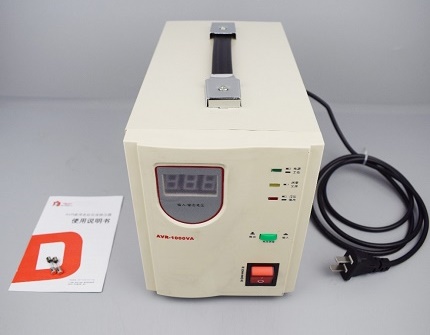
For the motor windings, both the prolonged presence of a low voltage and the long influence of a high inrush current due to a prolonged activation process at a low voltage are dangerous. As a result of exposure to high temperatures on the windings, it is very likely that the insulation will melt.
Voltage correction is required not only for modern samples of refrigeration equipment. Models of refrigerators released long ago are not equipped with protection against premature start.
Therefore, when the voltage is turned off and immediately abruptly turned on, the crank-rocker pair of the compressor suffers as a result of water hammer in the space above the piston. The stabilizer will turn off the power when the output voltage reaches its maximum, it will provide a delay before the next compressor starts.
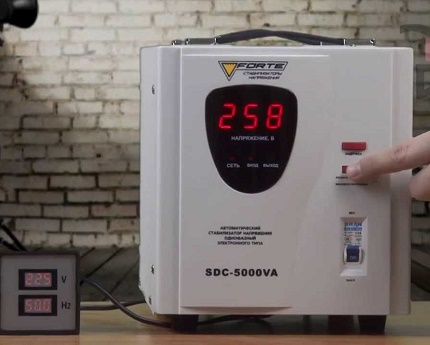
Before deciding to purchase a stabilizer, you need to make sure that the purchase is worthwhile. To do this, study the parameters of the existing electrical network. It is recommended to measure the voltage during several days during peak consumption.
It is advisable to use devices that fix the current voltage. Foreign manufacturers designate this feature as True PMS. If, according to the measurement results, it turns out that the controlled parameter did not exceed the limits of 205-235 V, the stabilizer will be required only for a new expensive model of the refrigerator.
Its elements are especially sensitive to differences. The situation is considered critical when the voltage deviations in the direction of increase exceed + 10% or -15% in the direction of decrease.

In this case, the connection of the stabilizer is a prerequisite. Most new models are equipped with built-in voltage stabilizers.
Their reliability is in doubt, because in practice, with large network congestion, they do poorly with their task. In a critical situation, they themselves can be damaged and the unit will remain completely unprotected.
Types of stabilizers for the refrigerator
Devices designed for voltage stabilization differ both in design and in output power, in principle of operation. According to these signs, three types of stabilizers for the refrigerator are distinguished: electromechanical, they are also servo-driven, relay, triac or electronic.
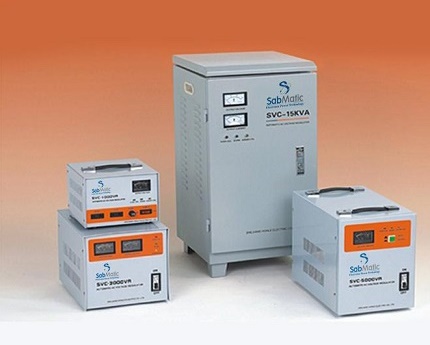
Subdivide stabilizers by type of power grid. They can be single and three phase. The first have compact dimensions, and as in their design there is no cooling fan, they are almost no noise during operation. The output voltage is monitored continuously, but the response level to the input voltage is quite low.
Three-phase stabilizers designed for heavy loads have been developed for houses powered by a 380 V mains, but when one of the phases fails, the protective mode does not work. Depending on the type of voltage in the network, the devices are divided into those operating with low, high and spasmodic voltages.
1. Electromechanical devices
Servo-driven devices control the drive of the current collector and control the voltage parameters through an electronic board. High accuracy is their main advantage, the error is only 2-4%. The disadvantage is the speed caused by the inertia of 10-20 volts.
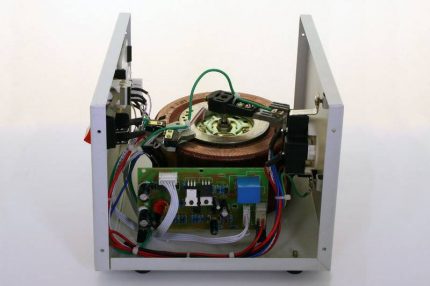
Such a stabilizer works well in conditions of either a slowly changing voltage, or stably low, or too high. With strong spasmodic swings, the device will quickly become unusable. Such conditions are most often observed in cottages, in country cottages, so this option is not suitable here.
2. Relay type stabilizer
A simple relay stabilizer control system can withstand significant swings. On its electronic unit, as well as on the controller, there are power relays that are responsible for switching the transformer windings. The transition takes place extremely quickly - in just 0.5 seconds.
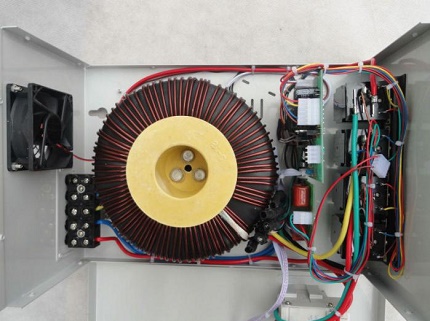
The weak link is the microcontroller. It can burn out, unable to withstand excessive mobility of the input voltage.
The work of switching the steps of the transformer is accompanied by clicks, which does not add comfort in the house. Such models are intended for use in networks where fast voltage reloads occur continuously.
3. System models of devices
There is no such element as a relay in the electronic stabilizer, the control is controlled by seven-voltors that quickly respond to the slightest changes in the network. The absence of mechanical contacts makes it possible to carry out multiple switching silently during power outages.
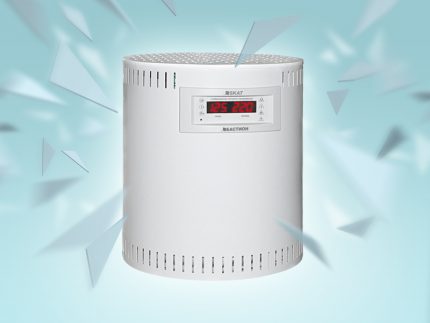
They withstand voltage overloads of up to 20% for 12 hours, and up to 100% for one minute. Manufacturers of system stabilizers make high demands on the quality of parts and the accuracy of assembly, therefore both the durability and the cost of the devices are appropriate.
Criteria for choosing a device for stabilization
The main criterion for choosing is power. This is followed by indicators such as voltage stabilization stages, response speed, accuracy and range. Auxiliary parameters - noise level, input voltage, the presence of additional options.
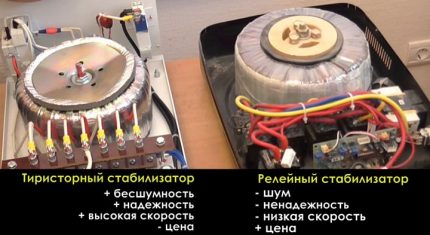
Calculation of the power of the stabilizer
This parameter is very important for the stabilizer. Here we mean the total power at the input under conditions of a voltage of 220 V. The active power characteristic of the refrigerator can be found from its passport, but the total power is involved in the calculations.
Since the refrigerator is an induction component, we are dealing with a reactive load in the circuit and an additional indicator - cos φ. This parameter can be found in the equipment certificate.
The total power is equal to the quotient of dividing the active power in watts by cos φ, which for the refrigerator is 0.9. If this value cannot be found, then the power should be divided by 0.7.
The refrigerator at startup has a large starting current, sometimes exceeding the rated current up to 5 times. For this reason, a three-fold increase in apparent power occurs. So, for a 600 W refrigeration unit, the maximum power will be: (600 x 3): 0.9 = 2000 W. Active power is added to the maximum power and the device power is obtained.
Since the stabilizer is a low-inertia device with a quick response to any changes in the load or the input network, it needs some power reserve. Otherwise start compressor motor refrigerator, will trigger a protective function due to overload.
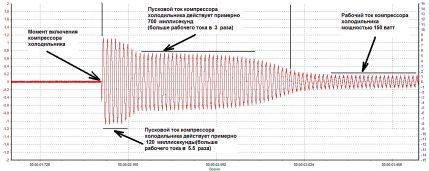
If the starting and rated power are known, it is possible to approach the calculation in a different way. For example, a Wirlpool ARC4020 refrigerator with a rated power of 200 watts and a starting power of 1000 watts.
You need to find the difference between these values: 1000 - 200 = 800 watts. Maximum power will be: 200 + 800 = 1000 watts. Given a 20% margin, the desired stabilizer power is found: 1000 x 1.2 = 1200 W = 1.2 kW.
If the stabilizer is planned to be installed not only for the refrigerator, but for all electrical appliances in general, the calculation of its power is performed according to the parameters of the machine. To do this, the voltage is multiplied by the current value, which is found by marking machine. When the voltage is 220 V and the current is 16 A, the stabilizer must have a voltage of 3520 W.
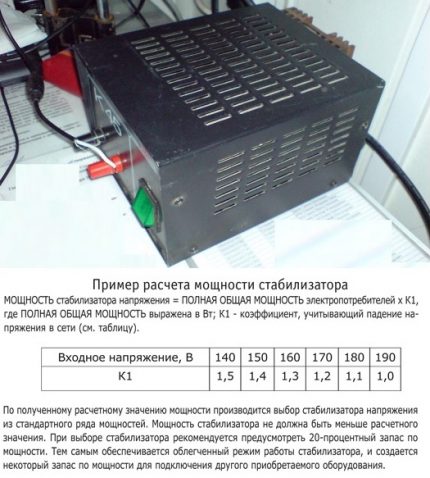
Speed selection
An unstable network requires a device with a high reaction rate. Therefore, the electromechanical stabilizer of the old type, operating on the basis of the LATR principle, is inappropriate in such conditions, because It has a low stabilization rate.
When a jump appears on the network, the time interval for setting the nominal value can drag out to three seconds. In conditions of a surge of very high voltage, the refrigerator will have time to fail.
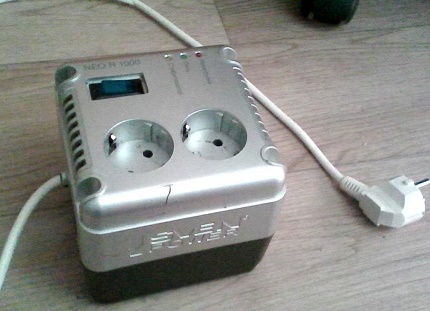
This drawback does not compensate even the high accuracy of the device. If we make a choice between a relay stabilizer and a seven-phase regulator according to this parameter, then their reaction to voltage drops is almost the same. In this case, the first type of device will cost less. The advantage of the second is absolute noiselessness.
Accuracy and stabilizer range
In the labeling of these devices, there is always such a parameter as accuracy. It is designated by the symbols "U", which means narrow and "Fri" - increased accuracy. There is also a marking in the form of the symbols "PTT", "PTTT".
For the refrigerator, usually choose the first two. The second two are necessary for equipment used in medicine in the case of large range fluctuations.
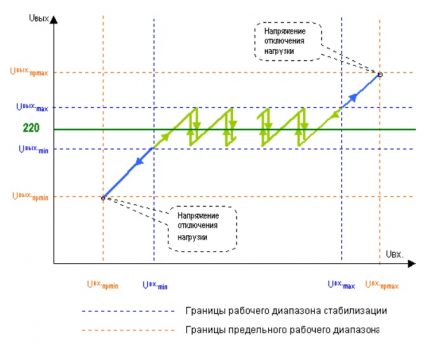
Among the three types of stabilizers, the dynamic type has the greatest accuracy. In the other two, voltage changes are stepwise. It is really impossible to get exactly 220 volts, at the input it will be either a little in the plus or a little in the minus in relation to the nominal. But these values will not exceed the tolerance laid down in GOST clause 4.2.2 of GOST 32144-2013.
Input voltage and other parameters
In domestic networks, a deviation from the standard 220 V is allowed, but not more than 10%. If you are sure that the tolerance will not be exceeded, then you do not need to buy a stabilizer, but this happens very rarely. Significantly more often, the spread of voltage values ranges from 140 to 270 V, or even more.
For this reason, when choosing a device, you need to look at the documentation. Here you will find the permissible input voltage range, and it is different for each model. Other parameters include noise level, input voltage geometry.
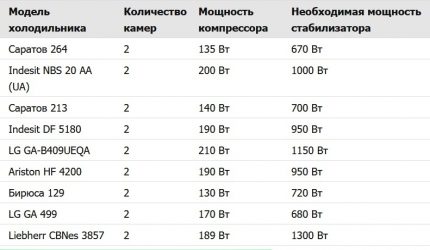
If a smooth sinusoid is needed for the device to work, then this point should be key when choosing a device. A plus for the stabilizer is the presence of such an option as bypass mode. This function paves the way for input voltage input directly.
If the voltage in the network complies with the regulation, it goes to the refrigerator directly. In case of deviations from the nominal value, the stabilizer is included in the circuit.
Features of the installation and connection of the stabilizer
In the passport of the stabilizer, manufacturers indicate the temperature regime that is optimal for its operation. The lowest temperature threshold for household single-phase devices is + 5⁰, for three-phase -5⁰С. The upper limit is + 45⁰. The heat generated by the stabilizer during operation is removed by ventilation - natural or forced.
In order for this system to function normally, the case of the device with ventilation holes is removed from the building envelope by a distance of about 0.5 m. If the stabilizer is not very heavy, it can be placed on a shelf or on a table, and suspended models are also found.
A device of a sufficiently large weight is placed on the floor, but so that under it there is no soft coating, worsening the conditions for normal ventilation. It is not recommended to have a stabilizer near the bedroom, as even at low noise levels, it will still interfere.
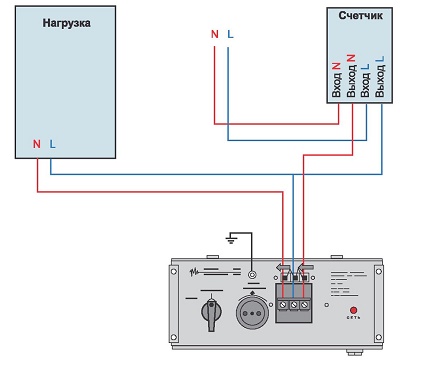
To supply normal quality power to the refrigerator, single-phase stabilizer models are used. As a rule, their power does not exceed 3 kW.
I have individual devices of this type on the back of the case one or two outlets and a cord with a plug. To connect the appliance to the network, you do not need to be a specialist. The plug is simply inserted into the outlet, and then the refrigerator is turned on through the stabilizer.
It happens that the case is equipped only with terminals, then the cord and plug are purchased additionally. The ends of the first are screwed to the terminals.
To fix the position of the electronic keys or brushes at which the supply of stabilized current begins, the stabilizer is first momentarily turned on. After the voltmeter readings stop at 220 V, the device is immediately turned off.
It remains to connect the wire with the outlet to the outlet, and the refrigerator into it. If 380 V is connected to the house, one three-phase stabilizer is installed, then its effect will extend not only to the refrigerator, but also to other electrical appliances. Another option is also used - three single-phase stabilizers with a star connection.
Safe operation
It should not be forgotten that the device does not have protection against moisture entering its body. Therefore, do not put any dishes with liquid on it, nor wipe it with a damp cloth. Detergents are also contraindicated in care.
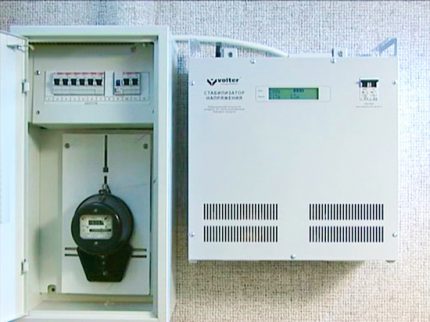
The electrical safety rules strictly prohibit the contact of the case with metal surfaces. Also, ventilation grilles must not be allowed to close, otherwise the device will overheat with a further failure.
Danger to the stabilizer and overload. It can occur when, in addition to the refrigerator, some other home appliances that are not taken into account when performing power calculations are connected to it.
If such a connection is necessary, you must first check to see if the total load exceeds the permissible limit. In any case, to protect several devices, it is better to purchase voltage regulator for home with the characteristics calculated for their work.
Manufacturers and models of stabilizers
The first place in the rating of household stabilizers is taken by the RUCELF SRFII-6000-L relay device of domestic production. Its design takes into account all the features of our electrical networks. It works stably in the voltage range from 110 to 270 V.
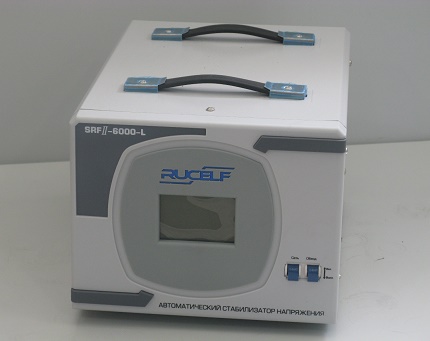
Among the high-quality devices offered by the International brand RUCELF, there are other good models. In particular, the RUCELF SDWII-6000-F compact vertical stabilizer of relay type with a power of about 6 kW is popular.
It is silent in operation, is fast-acting, emits little heat, operates in the range of 145-265 V. Its price is quite high, but there are additional options: delayed start, bypass, self-diagnosis system.
As a budget option, you can consider the Teplocom ST-555 Bastion model. It is designed for a wide range of voltages, but the accuracy rate is quite low - 8%. The device weighs only 2 kg.
The Teplocom ST-555 bastion is the best option for small objects with autonomous networks. It is compact, has wall placement, has a power of 7 kW.
If the noise does not frighten, then the Luxeon WDR-10000 model is quite acceptable for use in everyday life. Despite the Chinese assembly, the device works stably, has a stylish design. For both office and home use the wall-mounted Sven AVR PRO LCD 10000.
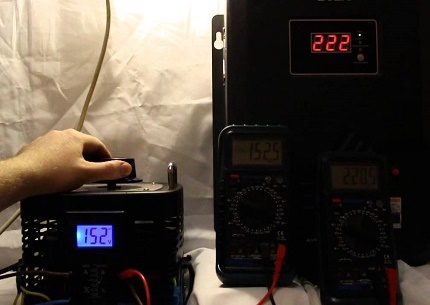
It has small dimensions, but heavy (18.5 kg), because high-quality components were used for assembly. The unit is noisy, but the voltage evens out smoothly. Since its power is high, it cannot be connected to a conventional outlet. When connecting, special terminals are used. There is no bypass in the design.
Conclusions and useful video on the topic
Material about the features of the choice of stabilizer:
How to calculate power correctly:
Stabilization of voltage is a topical issue. By purchasing such a device, you can extend the life of the refrigerator and other home equipment. Regret the acquisition can only make the wrong choice of stabilizer.
Please write comments in the block below, ask questions, post a photo on the topic of the article. Tell us about how CH was selected to protect the refrigerator from power surges. Perhaps your advice will provide effective assistance to site visitors.

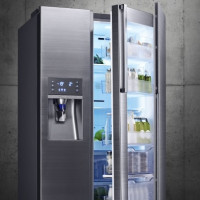 Indesit Refrigerator Repair: Find and Fix Common Problems
Indesit Refrigerator Repair: Find and Fix Common Problems 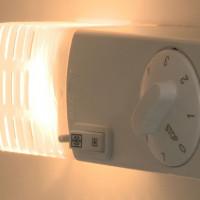 Bulb for the refrigerator: characteristics, types, selection rules + how to replace it yourself
Bulb for the refrigerator: characteristics, types, selection rules + how to replace it yourself  How to outweigh the refrigerator door: repair recommendations + step-by-step instructions
How to outweigh the refrigerator door: repair recommendations + step-by-step instructions 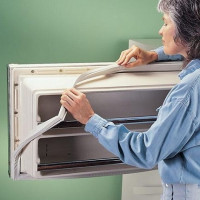 Sealant for the refrigerator: rules for choosing and replacing the sealing gum
Sealant for the refrigerator: rules for choosing and replacing the sealing gum  Temperature regulator for the refrigerator: device, check + subtleties of replacement if necessary
Temperature regulator for the refrigerator: device, check + subtleties of replacement if necessary 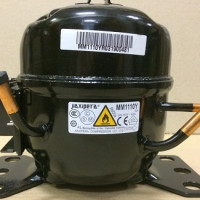 Compressor for the refrigerator: an overview of frequent breakdowns + step-by-step instructions for replacing
Compressor for the refrigerator: an overview of frequent breakdowns + step-by-step instructions for replacing  How much does it cost to connect gas to a private house: the price of organizing gas supply
How much does it cost to connect gas to a private house: the price of organizing gas supply  The best washing machines with dryer: model rating and customer tips
The best washing machines with dryer: model rating and customer tips  What is the color temperature of light and the nuances of choosing the temperature of the lamps to suit your needs
What is the color temperature of light and the nuances of choosing the temperature of the lamps to suit your needs  Replacement of a geyser in an apartment: replacement paperwork + basic norms and requirements
Replacement of a geyser in an apartment: replacement paperwork + basic norms and requirements
We have constant surges of electricity at the cottage, starting from 170 and pumping 250, of course, that this does not benefit all equipment. But since only the refrigerator is constantly working, and the rest of the equipment is occasional, the stabilizer has only been connected to it for now. It does not create much noise and at the same time stably equalizes voltage. We have an ERA, the only negative is that it is quite bulky.
Gennady, what’s your refrigerator in the country? We just installed the stabilizer only when we bought a terribly expensive Samsung two-door refrigerator for us. Because we will not survive his death, but in the country we have been idle for many years now, working around the clock and without a stabilizer. I generally did not know before what it is and what it is eaten with. And they didn’t put anything on the old refrigerator at home. How is the era? Norm?
Well, yes, in the country there are usually refrigerators that are cheaper than this ERA stabilizer, although it is inexpensive. But here I live outside the city and faced with the problem of power surges, and I have a normal refrigerator - LG. Here you have to protect yourself.
Alexander, do you have LG with an inverter compressor? How was the required stabilizer power calculated?
Hello. In your case, you can purchase a delayed voltage control relay or a 2000 VA stabilizer.
Good afternoon, and what stabilizer do you recommend for connecting Liebher side-by-side? There is a refrigerator and a freezer separately: two units with separate outlets.